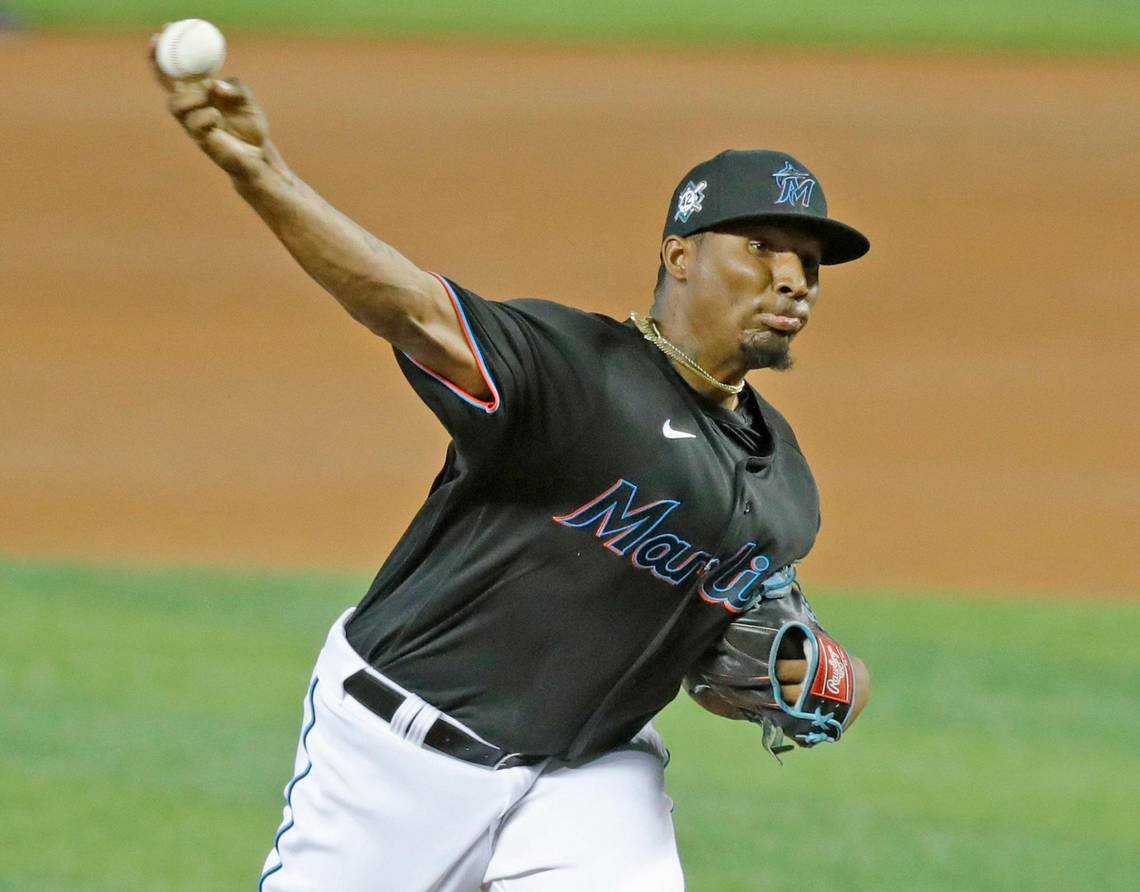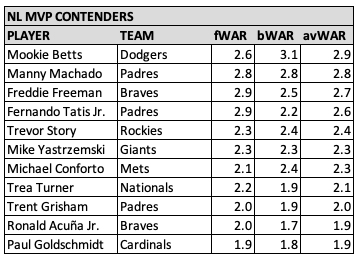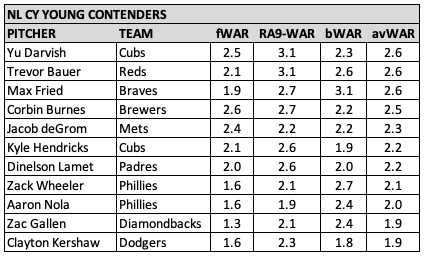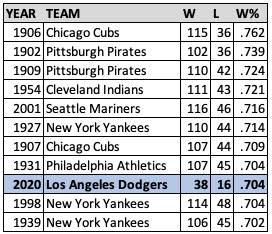National League’s Final Week Fun

With one week left in the regular season, the only thing we know for sure heading into the National League’s final week is that the Dodgers and Padres are in the playoffs. The Cubs and Braves are in the driver’s seat for the top spots in their divisions, but it’s mass chaos for the second spots in the East and Central and the two wild card entries.
NL East
Atlanta Braves, 31-22, .585, +59 run-differential
4 vs Marlins (.528), 3 vs Red Sox (.370)
The Braves control their own destiny in the NL East, starting with a four-game set against the 2nd place Miami Marlins. Even a split in the series would be enough to make it very difficult for the Marlins to catch them for the division title. Then they get to beat up on the Red Sox historically bad pitching staff. Should they wrap things up early, they can still let Freddie Freeman add to his NL MVP case. According to the average of FanGraphs and Baseball-Reference WAR, Freeman is currently third in the National League, with teammate Ronald Acuña Jr. also in the top 10.

Miami Marlins, 28-25, .528, -26 run-differential
4 @ Braves (.585), 3 @ Yankees (.585)
The Marlins’ dream scenario is a four-game sweep of the Braves to take over first place in the NL East. Of course, then they have to face the red-hot Yankees in New York, which is a whole different dream for later in the week. One dream at a time, Marlins fans.
Philadelphia Phillies, 27-26, .509, +3 run-differential
4 @ Nationals (.385), 3 vs Rays (.648)
The Phillies are fighting a battle on two fronts. They’re trying to catch the Marlins in the NL East (1 game back) and looking to stay ahead of a pack of teams gunning for a wild card spot. Unfortunately, they’re doing it with a bullpen that has a 7.15 ERA. The last time a team had a higher ERA from their bullpen was in 1950, when the relievers for the Athletics (7.77), Browns (7.40), and Red Sox (7.29) were regularly knocked around the ballpark. The Phillies tried to fix their pen by acquiring four relievers before the trade deadline, but Heath Hembree (10.13 ERA), David Phelps (9.39 ERA), and Brandon Workman (6.94 ERA) brought gasoline cans instead of fire hoses and have only added to the inferno. The fourth reliever, David Hale (4.05 ERA), has been fine.
New York Mets, 24-29, .453, -9 run-differential
3 vs Rays (.648), 4 @ Nationals (.385)
They’ve only played about one-third of a season, but this Mets team has the best offense in franchise history, and it’s not particularly close. As a team, the Mets are hitting .278/.355/.463. That’s the second-highest batting average, second-highest on-base percentage, and highest slugging percentage for any season in team history. Their 124 wRC+ is 13 points better than the next-best Mets team, which is the 1988 version (111 wRC+). Despite the productive bats, the Mets need a fantastic final week to make the postseason. As Tug McGraw once said, “You gotta believe!”
Washington Nationals, 20-32, .385, -35 run-differential
4 vs Phillies (.509), 4 vs Mets (.453)
For a second year in a row, the Nationals went 19-31 in their first 50 games. Last year, they recovered to make the playoffs and eventually won the World Series. This year, they won’t even make a 16-team post-season. Where’s the “Baby Shark” song when you need it?
NL Central
Chicago Cubs (31-22, .585), +21 run-differential
4 @ Pirates (.283), 3 @ White Sox (.642)
The Cubs should secure a playoff spot during their four-game series with the woeful Pittsburgh Pirates. Then they can turn their focus on Yu Darvish and his bid for the NL Cy Young Award. Before Sunday’s games, Darvish, Trevor Bauer, Max Fried, and Corbin Burnes were all very close in a combination of Wins Above Replacement metrics from FanGraphs and Baseball-Reference. Another Cubs pitcher, Kyle Hendricks, is also among the top six, along with Jacob deGrom.

St. Louis Cardinals, 26-24, .520, +11 run-differential
3 @ Royals (.396), 5 vs Brewers (.500)
If things fall into place early in the week, baseball fans could experience the joy of watching the Cardinals and Brewers play a five-game series in which every game is meaningful. This would include a double-header on Friday in which the Brewers will be the home team at Busch Stadium. Keep your fingers crossed, baseball fans.
Cincinnati Reds, 27-27, .500, -10 run-differential
3 vs Brewers (.500), 3 @ Twins (.600)
We could end up with four teams from the Central making the playoffs. The Reds, Cardinals, and Brewers are all vying for 2nd place in the NL Central, which would give them an automatic spot in the post-season. They’re also vying for a wild card spot if they don’t get that automatic berth. Should any team end up tied at the end of the regular season, there will NOT be any tie-breaker games. Instead, MLB will use these mathematical scenarios to break the tie.
If two teams tie:
- Head-to-head record, if applicable.
- Division record, if the teams are not in the same division.
- Highest winning percentage versus their own division over the last 20 intradivision games (plus one game until the tie is broken).
If more than two teams tie, well, that gets complicated (check the link above for that scenario).
The first three games of the week against the Brewers are huge for the Reds, which is good because Joey Votto has been a beast with the bat at home but hasn’t hit a lick on the road.
Milwaukee Brewers, 26-26, .500 -3 run-differential
3 @ Reds (.500), 5 @ Cardinals (.520)
With eight games this week against division rivals, the Brewers are in desperate need of the 2018-2019 version of Christian Yelich. So far this year, they’ve only had the 2015 vintage, which has been decidedly less tasty. Ideally, Yelich could morph himself back into the guy who hit .357/.526/.750, with 8 runs, 3 home runs, and 9 RBI in an-eight game stretch last September.
Pittsburgh Pirates, 15-38, .283, -88 run-differential
4 vs Cubs (.585), 3 @ Cleveland (.547)
Currently on a run of 11 losses in their last 12 games, the Pirates need three wins in their last seven games to avoid finishing with a winning percentage below .300. It’s not impossible. They won five of seven from August 21 through August 27 and four of seven in early September. Still, it’s not likely either, not the way this team is playing. Should they finish with a winning percentage below .300, it will be only the second time they’ve done so since 1901. The previous time was in 1952, when they were 42-112 (.273).
NL West
Los Angeles Dodgers 38-16, .704, +119 run-differential, clinched playoff spot
3 vs Athletics (.623), 3 vs Angels (.426)
The short list of MLB teams who won 70 percent of their games in a season (since 1901):

True, it’s only been one-third of a season, but these Dodgers have been really, really good. They’ve won slightly more than 70 percent of their games despite Cody Bellinger not coming close to last year’s NL MVP performance. Also, Justin Turner has been limited to 36 games and Max Muncy is struggling to get on base and hit for power (96 wRC+).
The Dodgers are good because Mookie Betts has been a terrific offseason addition, as everyone expected he would be. Corey Seager is having his best season. Chris Taylor has been terrific at the dish while playing second base, shortstop, center field, and left field. Oh, and the Dodgers pitching staff leads baseball with a 3.00 ERA.
San Diego Padres, 34-20, .630, +84 run-differential, clinched playoff spot
2 vs Angels (.426), 4 @ Giants (.500)
The Padres have essentially locked in the #4 seed in the NL for the postseason, which means they’ll face the 2nd place team from the NL East or NL Central in the first round. That’s fine. It could be the Marlins or Phillies or Cardinals or Reds or Brewers. Whatever.
The second round is where the fun starts because the winner of the #1 versus #8 matchup faces the winner of the #4 versus #5 matchup. This is where the Padres could take on their division rivals, the Los Angeles Dodgers. It’s a shame this won’t be the NLCS, really. Instead, one of the two best teams in the league will be knocked out and the other will face the Cubs or the Braves or one of the gelatinous blob of teams currently straddling .500. This is all 2020’s fault.
San Francisco Giants, 26-26, .500, +5 run-differential
4 vs Rockies (.442), 4 vs Padres (.630)
Against teams with a winning record, the Giants are 7-18 (.280) this year. Against teams with a losing record, they’re 19-8 (.704). Basically, they’re the Los Angeles Dodgers when they play losing teams and the Pittsburgh Pirates when they play winning teams. That doesn’t seem like a recipe for success should they make the playoffs.
Colorado Rockies, 23-29, .442, -65 run-differential
4 @ Giants (.500), 4 @ Diamondbacks (.370)
Yes, it’s a shortened season, but the 2020 Rockies are currently the worst-hitting team in franchise history. Their 76 wRC+ is six points worse than the 2002 Rockies. They have the lowest batting average and on-base percentage in team history and are tied for the lowest slugging percentage. Overall, they’re hitting .255/.311/.410, which includes a .223/.295/.364 batting line away from their hitter-friendly ballpark.
In related news, Charlie Blackmon started the season with 34 hits in his first 68 at-bats. That’s a .500 batting average. Since then, he’s gone 24-for-120, which is a .200 batting average. That’s not what you want.
Arizona Diamondbacks, 20-34, .370, -48 run-differential
2 vs Rangers (.358), 4 vs Rockies (.442)
The Diamondbacks are one of six MLB teams with a winning percentage under .400. In a typical year, they would be in the running for one of the top selections in the 2021 MLB Amateur Draft. As everyone knows, 2020 is not a typical year. MLB has not yet revealed how the 2021 draft order will be decided. The agreement between MLB and the MLBPA to play 60 games this year gave commissioner Rob Manfred the right to decide how the draft order will be determined. Manfred could have the draft determined by this season’s records or he could combine 2019 and 2020 in some way to determine the draft order. We just don’t know yet.
This will make a difference for the Diamondbacks. While their .370 winning percentage in 2020 is tied for third-worst in baseball, in 2019 they had a .525 winning percentage. How Manfred decides to determine the draft order could mean the difference between a top-five pick for the Diamondbacks versus a mid-first round pick.
-Bobby Mueller
















